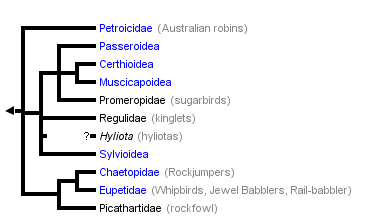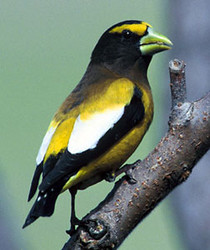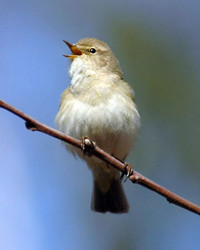Passerida
John Harshman


This tree diagram shows the relationships between several groups of organisms.
The root of the current tree connects the organisms featured in this tree to their containing group and the rest of the Tree of Life. The basal branching point in the tree represents the ancestor of the other groups in the tree. This ancestor diversified over time into several descendent subgroups, which are represented as internal nodes and terminal taxa to the right.

You can click on the root to travel down the Tree of Life all the way to the root of all Life, and you can click on the names of descendent subgroups to travel up the Tree of Life all the way to individual species.
For more information on ToL tree formatting, please see Interpreting the Tree or Classification. To learn more about phylogenetic trees, please visit our Phylogenetic Biology pages.
close boxDiscussion of Phylogenetic Relationships
Passerida was erected by Sibley and Ahlquist (1990) as a sister group to Corvida; together they encompassed all the oscines. While Corvida has been shown not to exist as a group, Passerida has survived roughly intact, as have most of the superfamilies within it.
Picathartidae (rockfowl), Chaetopidae (rockjumpers), Eupetidae (whipbirds and allies) and Petroicidae (Australian robins) are basal members of Passerida (Barker et al. 2002, 2004; Beresford et al. 2005, Jønsson et al. 2007). Regulidae (kinglets) and Hyliota are closer to other Passerida than the previous two families, but cannot so far be linked to any of the superfamilies (Barker et al. 2002, 2004; Ericson and Johansson 2003; Beresford et al. 2005; Fuchs et al. 2006).
Three of the passeridan superfamilies, Sylvioidea, Muscicapoidea, and Passeroidea, are roughly similar to Sibley and Ahlquist’s (1990) groups (Sheldon and Gill 1996; Barker et al. 2002, 2004; Ericson and Johansson 2003; Beresford et al. 2005). It has however been necessary to add a fourth, Certhioidea (Cracraft et al. 2004, Barker et al. 2004). Sylvioidea is sister to all other passeridan superfamilies, and Muscicapoidea is sister to Certhioidea (Sheldon and Gill 1996; Barker et al. 2002, 2004; Beresford et al. 2005).
It may be that Promeropidae (sugarbirds) is the basal family in Passeroidea, but that conclusion is weakly supported, and only by different versions of one data set (Barker et al. 2002, 2004; Beresford et al. 2005). What may be partial confirmation is offered by Fuchs et al. (2006). The two genera Modulatrix (spot-throat) and Arcanator (dapple-throat, sometimes merged into Modulatrix) are strongly supported as the sister group of Promerops (Barker et al. 2002, 2004; Beresford et al. 2005). Fuchs et al. (2006), again with weak support, show Modulatrix and Arcanator as the sister group of Passeroidea, but Promerops appears in a polytomy at the base of Passerida, and in light of the ambiguity of this information, it seems best to leave the entire family there. However, there does seem to be good evidence for inclusion of those two species, whose relationships have previously been highly uncertain (Sibley and Monroe 1990), as sister taxa within Promeropidae.
References
Barker, F. K., G. F. Barrowclough, and J. G. Groth. 2002. A phylogenetic hypothesis for passerine birds; Taxonomic and biogeographic implications of an analysis of nuclear DNA sequence data. Proc. R. Soc. Lond. B 269:295-308.
Barker, F. K., A. Cibois, P. Schikler, J. Feinstein, and J. Cracraft. 2004. Phylogeny and diversification of the largest avian radiation. Proc. Natl. Acad. Sci. USA 101:11040-11045.
Beresford, P., F. K. Barker, P. G. Ryan, and T. M. Crowe. 2005. African endemics span the tree of songbirds (Passeri): Molecular systematics of several evolutionary "enigmas". Proc. R. Soc. Lond. B 272:849-858.
Cracraft, J., F. K. Barker, M. J. Braun, J. Harshman, G. Dyke, J. Feinstein, S. Stanley, A. Cibois, P. Schikler, P. Beresford, J. Garcia-Moreno, M. D. Sorenson, T. Yuri, and D. P. Mindell. 2004. Phylogenetic relationships among modern birds (Neornithes): Toward an avian tree of life. Pages 468-489 in Assembling the tree of life (J. Cracraft and M. J. Donoghue, eds.). Oxford University Press, New York.
Ericson, P. G. P., and U. S. Johansson. 2003. Phylogeny of Passerida (Aves: Passeriformes) based on nuclear and mitochondrial sequence data. Mol. Phylogen. Evol. 29:126-138.
Fuchs, J., J. Fjeldså, R. C. K. Bowie, G. Voelker, and E. Pasquet. 2006. The African warbler genus Hyliota as a lost lineage in the oscine songbird tree: Molecular support for an African origin of the Passerida. Mol. Phylogen. Evol. 39:186-197.
Harshman, J. 1994. Reweaving the Tapestry: What can we learn from Sibley and Ahlquist (1990)? Auk 111:377-388.
Harshman, J. 2007. Classification and phylogeny of birds. Pages 1-35 in Reproductive biology and phylogeny of birds (B. G. M. Jamieson, ed.). Science Publishers, Inc., Enfield, NH.
Jonsson, K. A., J. Fjeldså, P. G. P. Ericson, and M. Irestedt. 2007. Systematic placement of an enigmatic Southeast Asian taxon Eupetes macrocerus and implications for the biogeography of a main songbird radiation, the Passerida. Biology Letters 3(3):323-326.
Sheldon, F. H., and F. B. Gill. 1996. A reconsideration of songbird phylogeny, with emphasis on the evolution of titmice and their sylvioid relatives. Syst. Biol. 45:473-495.
Sibley, C. G., and J. A. Ahlquist. 1990. Phylogeny and classification of birds, Yale U. Press, New Haven.
Sibley, C. G., and B. L. Monroe Jr. 1990. Distribution and taxonomy of birds of the world, Yale University Press, New Haven.
Title Illustrations

| Scientific Name | Hesperiphona vespertina |
|---|---|
| Location | Klamath Falls, California, USA |
| Comments | Evening Grosbeak |
| Creator | Dave Menke |
| Specimen Condition | Live Specimen |
| Source Collection | U.S. Fish and Wildlife Service Online Digital Media Library |
| Scientific Name | Bombycilla cedrorum |
|---|---|
| Acknowledgements | Photograph courtesy InsectImages.org (#1372026) |
| Specimen Condition | Live Specimen |
| Source Collection | Bugwood Network/Forestry Images |
| Copyright | © Ricky Layson, Forest Resource Consultants, Inc. |
| Scientific Name | Phylloscopus collybita |
|---|---|
| Location | Russia, Moscow region, Bashkino |
| Specimen Condition | Live Specimen |
| Source | Chiffchaff |
| Source Collection | Flickr |
| Image Use |
 This media file is licensed under the Creative Commons Attribution-NonCommercial-NoDerivs License - Version 2.0. This media file is licensed under the Creative Commons Attribution-NonCommercial-NoDerivs License - Version 2.0.
|
| Copyright | © 2006 Sergey Yeliseev |
About This Page
Correspondence regarding this page should be directed to John Harshman at
Page copyright © 2006
 Page: Tree of Life
Passerida.
Authored by
John Harshman.
The TEXT of this page is licensed under the
Creative Commons Attribution-NonCommercial License - Version 3.0. Note that images and other media
featured on this page are each governed by their own license, and they may or may not be available
for reuse. Click on an image or a media link to access the media data window, which provides the
relevant licensing information. For the general terms and conditions of ToL material reuse and
redistribution, please see the Tree of Life Copyright
Policies.
Page: Tree of Life
Passerida.
Authored by
John Harshman.
The TEXT of this page is licensed under the
Creative Commons Attribution-NonCommercial License - Version 3.0. Note that images and other media
featured on this page are each governed by their own license, and they may or may not be available
for reuse. Click on an image or a media link to access the media data window, which provides the
relevant licensing information. For the general terms and conditions of ToL material reuse and
redistribution, please see the Tree of Life Copyright
Policies.
- First online 22 June 2006
- Content changed 23 June 2008
Citing this page:
Harshman, John. 2008. Passerida. Version 23 June 2008 (under construction). http://tolweb.org/Passerida/29223/2008.06.23 in The Tree of Life Web Project, http://tolweb.org/












 Go to quick links
Go to quick search
Go to navigation for this section of the ToL site
Go to detailed links for the ToL site
Go to quick links
Go to quick search
Go to navigation for this section of the ToL site
Go to detailed links for the ToL site